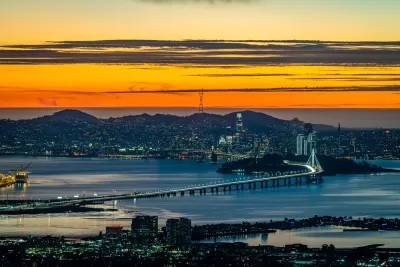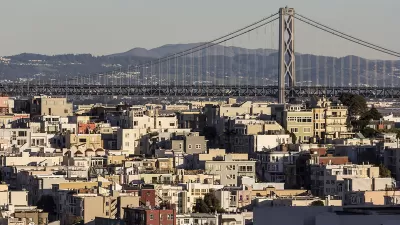A traditionally controversial planning exercise, the regular update of the 30-year plan for the San Francisco Bay Area, has crossed the finish line again. Opponents aren't letting the issues rest, however.

The Metropolitan Transportation Commission and the Association of Bay Area Governments adopted Plan Bay Area 2050 and its accompanying Environmental Impact report on Thursday, October 21. Planetizen last checked in with the 30-year regional plan when the two organizations released the draft for the nine-county regional plan in July 2020.
A summary of the vision put forward by Plan Bay Area 2050 are found in a press release announcing the adoption of the plan on October 21:
Defined by 35 strategies for housing, transportation, economic vitality and the environment, Plan Bay Area 2050 lays out a $1.4 trillion vision for policies and investments to make the nine-county region more affordable, connected, diverse, healthy and economically vibrant for all its residents through 2050 and beyond.
The press release claims the plan will produce more than one million new permanently affordable homes by 2050 and achieve a "groundbreaking focus on climate change," with strategies to create resilience from environmental risks like sea-level rise and wildfires.
Critics are skeptical, however, that the vision can be achieved with exacerbating the trends of gentrification and displacement that have defined the housing market in large swaths of the Bay Area in recent years (or decades).
Bobbi Lopez, policy director at Build Affordable Faster California and co-founder of the San Francisco Latino Democratic Club, pens an opinion piece criticizing Plan Bay Area 2050 for failing to work toward a more equitable and affordable Bay Area by relying too much on the market to deliver housing.
Lopez describes the plan as stuck in 1981: "I suppose its authors have turned a blind eye to corrupt real estate developers who have spent decades gentrifying our neighborhoods with fancy condominiums suited for the ultra-rich."
To achieve the plan's promised social equity, Lopez suggests funding homelessness programs, mandating a requirement that "50% of new housing developed on publicly-owned property be affordable for lower- and middle-income households," and making better choices about where to locate market-rate development. On that last point, Lopez writes: "Our region is home to hundreds of miles of empty shopping mall parking lots. With a little political will, that wasted blacktop could transform into new, market-rate apartment buildings, parks and small businesses — without displacing anyone."
Updated every five years, Plan Bay Area has provoked controversy in past iterations. Gentrification was among the criticisms of Plan Bay Area in 2015, for example. Opposition from environmentalists produced a protracted legal dispute that finally reached resolution in 2017. Right wing political interests, represented by the libertarian Pacific Legal Foundation, fought the Plan Bay Area process in 2013.
FULL STORY: Opinion: Plan Bay Area misses the mark for the working class

Alabama: Trump Terminates Settlements for Black Communities Harmed By Raw Sewage
Trump deemed the landmark civil rights agreement “illegal DEI and environmental justice policy.”

Planetizen Federal Action Tracker
A weekly monitor of how Trump’s orders and actions are impacting planners and planning in America.

The 120 Year Old Tiny Home Villages That Sheltered San Francisco’s Earthquake Refugees
More than a century ago, San Francisco mobilized to house thousands of residents displaced by the 1906 earthquake. Could their strategy offer a model for the present?

In Both Crashes and Crime, Public Transportation is Far Safer than Driving
Contrary to popular assumptions, public transportation has far lower crash and crime rates than automobile travel. For safer communities, improve and encourage transit travel.

Report: Zoning Reforms Should Complement Nashville’s Ambitious Transit Plan
Without reform, restrictive zoning codes will limit the impact of the city’s planned transit expansion and could exclude some of the residents who depend on transit the most.

Judge Orders Release of Frozen IRA, IIJA Funding
The decision is a victory for environmental groups who charged that freezing funds for critical infrastructure and disaster response programs caused “real and irreparable harm” to communities.
Urban Design for Planners 1: Software Tools
This six-course series explores essential urban design concepts using open source software and equips planners with the tools they need to participate fully in the urban design process.
Planning for Universal Design
Learn the tools for implementing Universal Design in planning regulations.
Clanton & Associates, Inc.
Jessamine County Fiscal Court
Institute for Housing and Urban Development Studies (IHS)
City of Grandview
Harvard GSD Executive Education
Toledo-Lucas County Plan Commissions
Salt Lake City
NYU Wagner Graduate School of Public Service





























